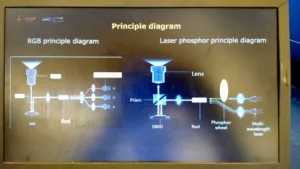Several companies were at CinemaCon showcasing their RGB or laser phosphor laser sources for use in projectors for theatrical use. These included Moving Images Technology, China Film Co. and Power Technology.
Moving Images Technology is a professional and home theatrical integrator offering lifts and mounts, plus full integration of the projector, screen, speakers and audio components. They were also showing an RGB laser source that comes from NEC (with fiber lasers from IPG Photonics). This is the same RGB laser source and chiller used in the NEC 3540 projector. They are a master reseller of the NEC projector line, so the source will clearly go with an NC projector. What was unclear is if they would couple the source to other projectors and do a retrofit solution (probably not).
CineAppo was formed in August 2014 as a partnership between China Film Equipment Co., Appotronics Corp. and Shenzhen Resources Investment & Development Co. CFE is an established equipment provider for the China cinema industry and Appotronics is a technology company that has developed laser phosphor technology for cinema projectors (which they supply to Barco). The third group is the local government which is likely financing the joint venture with the aim of expanding the technology and services to an international market. That’s why they were at CinemaCon.
CineAppo has developed three generations of its Advanced Laser Phosphor Display (ALPD). We believe generations 1 and 2 is conventional blue laser pumped yellow phosphor architectures. Generation 3 is different as it is now multicolor laser architecture. Altogether, CINEAPPO says they have completed 2500 retrofit upgrades of Barco projectors in China to laser phosphor sources.
The generation 3 technology is an RGB laser + green phosphor hybrid solution. The left side in the diagram below shows the conventional RGB laser source, which for high power applications includes a frequency-doubled green laser. These are expensive, so CineAppo developed the hybrid solution on the right.
Here, RGB laser diode sources are used in addition to the green laser phosphor solution (pumped by blue laser diodes). By using the green phosphor component to get the desired higher luminance, they can eliminate the costly frequency-doubled laser. This will desaturate the green primary, so it will not have as wide a gamut as an RGB source, but it should be able to obtain DCI-P3. Total lumen output ranges from 10K to 40K lumens with a service life of 30K hours to 80% of original luminance.
Power Technology had a suite where they were presenting their RGB laser solutions. They are a long time laser maker and have been developing high power RGB laser sources for cinema for a couple of years. They offer RGB sources that can be fiber coupled to the projector and they will retrofit any projector on the market. Normally, such retrofitting will void the warranty, so Power technology will assume the rest of the warranty on the projector to ease any fears from their customers. They can work with all series I and series II projectors.
The company has also been promoting its laser farm concept where all the RGB laser sources are housed in a central location with fiber running to projectors in various theaters. It does not appear as if any customers have implemented this solution yet, however.
Power technology recommends that screens requiring more than 20K lumens should go in the RGB direction with screens lower than that adopting laser phosphor. That’s purely an economic calculation. Christie says the dividing line should be 10K lumens, yet Barco is offering laser phosphor projector up to 33K lumens now, so this debate is clearly on-going.
Power Technology then showed some trailers using their RGB laser source on an older Series I DP2500 Barco projector. They showed clips from “Dunkirk” to showcase skin tones, “Ninjago” for color and “Wonder Woman” for color and skin tones. These clips looked very good and as one attendee noted, much improved from the last time she saw it.
The company has its own ROI calculator and will service cinemas through an established network of installation and maintenance partners.
Interestingly, speckle does not seem to be an issue with any of the RGB laser images I have seen lately. This was a hot topic for several years, but does not come up much anymore. – CC

